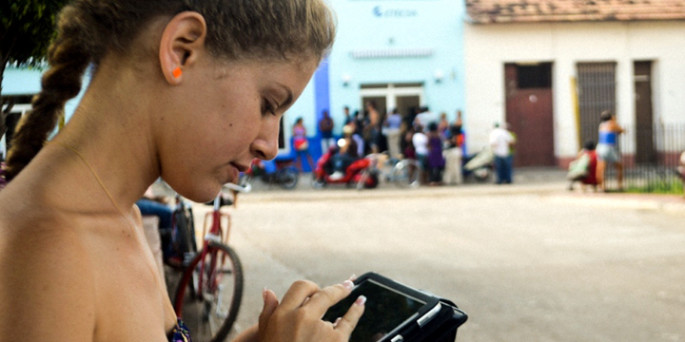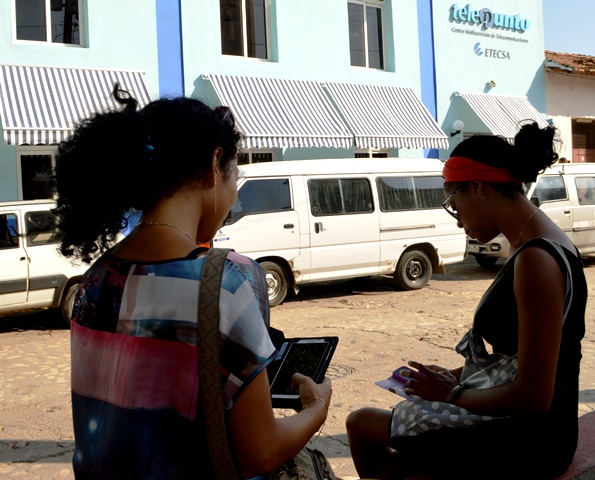
Wi-Fi zones in Cuba: Internet is in the air
SANCTI SPÍRITUS-. With the antennas in Trinidad working full blast for nearly a month, and the town of Yayabo about to climb on the wagon of wireless Wi-Fi, the province of Sancti Spiritus places two of its cities on the Top Ten Wi-Fi hosts in Cuba.
In April, a Carrillo de Trinidad public square in south-central Cuba became the second public place on the island where people can access the Internet thanks to “wireless fidelity.” The nearby city of Sancti Spiritus is about to make that service available in areas of its historic center.
[Translator’s Note: Though commonly called “wireless fidelity,” Wi-Fi is defined as the standard wireless local-area network (WLAN) technology for connecting computers and other electronic devices to each other and to the Internet.]
Only two or three public places with Wi-Fi in Cuba? The disclosure, though novel here, may seem old-hat in much of the world (even in underdeveloped nations), where Wi-Fi waves coexist with local citizens without trauma or media hubbub.
Nevertheless, here on the island, a connection to the Internet “through the air” is quite a novelty.
However, the starting whistle was not blown by the Cuban Communications Company (ETECSA), which had been drawing a plan — as ambitious as it was slow — to install technology that might create Wi-Fi zones nationwide.
According to the CubaSí portal, it was the renowned artist Alexis (Kcho) Leyva who stole the show when he placed at the service of the community the ADSL connection [asymmetrical digital subscriber line] granted to him by the Ministry of Culture.
With a speed of 2 megabytes per second and absolutely free of charge, access to the Internet from Kcho’s Romerillo Studio (A Laboratory for Art) became a sort of a landmark event. Ever since, Wi-Fi has been perceived not as a potential threat but as an alternative to broaden the capacity for connection.
In a recent interview with the daily Juventud Rebelde, ETECSA officials revealed the existence in Cuba of 89 Wi-Fi areas in hotels and airports for use primarily by tourists. However, Cuban citizens “borrowed” the wireless signal from outside those public facilities.
Other zones will be created in the future as part of the project established by ETECSA to extend this navigation system, which is much more efficient and less costly for ETECSA, since it does not require major investments in physical networks or computer centers.
It is less costly for ETECSA than for the population, I must point out, because Cubans must first open a Nauta account. And the fee for access to the Internet through Wi-Fi — 4.50 convertible pesos an hour (US$4.50) — is clearly a prohibitive price for a large segment of Cubans.
Little more than a month after their activation and despite the high cost, the three access points at the Telecommunications Center of Trinidad guarantee a bandwidth broad enough to allow a simultaneous connection by 90 users, the downloading of data, and swift navigation through cyberspace.
That’s according to Luis Rolando González Sánchez, director of ETECSA’s Territorial Division in Sancti Spiritus, who also explains that the devices now in operation will be improved.
“We anticipate the purchase of equipment with Chinese technology with wider reach and bigger capacity,” he says. “This will enable us to set up the new connections in tourist facilities and other places with a high concentration of users.”
Among the cities that soon will benefit from Wi-Fi is Sancti Spiritus, capital of the homonymous province which, while it doesn’t receive as many tourists as Trinidad, is becoming something of a communications emporium.
The service will be extended gradually to other sites, according to ETECSA officials in an online interview with the newspaper Escambray.
“About the cost, we still don’t have all the necessary information,” says Gustavo López Cruz, head of the Commercial and Marketing Department of ETECSA’s Territorial Division in Sancti Spiritus. “The fee for Internet access remains 4.50 convertible pesos an hour. As to the quality of connection, our company is using technology that meets international standards.”
As of now, Spirituans who have activated their Nauta accounts and own laptops, tablets or smart phones can navigate through cyberspace while sitting on a bench at Serafín Sánchez Park, walking down the street or in their homes.
That’s a reality that a few months ago not even Nostradamus would have dared to predict.
AT CAYO COCO HOTEL, WI-FI IN EVERY ROOM
Cuba’s first hotel to offer Wi-Fi in every room won’t be in Havana but rather at a beach resort in Cayo Coco on the north side of the island nation, the Los Angeles Times reported on Wednesday (May 27).
The French company Accor Hotels, which operates international brands Sofitel, Pullman and Novotel, made the Wi-Fi promise in announcing that it plans to open the luxury Pullman Cayo Coco Hotel in November.
The hotel is to have 518 rooms and face a long stretch of Los Colorados Beach.
The idea of a luxury resort with Wi-Fi is part of making Cuba more attractive to visitors. Recently relaxed rules for U.S. travelers have opened the door to American interest, The L.A. Times points out in its report.


